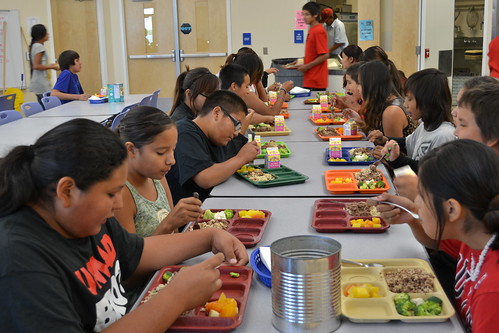
An ancient belief held by tribal communities is that the soil is cared for by Mother Earth, the nurturer and the protector of the land. This idea speaks to the importance of farm to school efforts in tribal communities. And many tribal communities are reconnecting children with their rich history and cultures by establishing farm to school programs.
Tribes are integrating traditional foods into the Child Nutrition Programs, sourcing foods locally, incorporating multicultural nutrition education into classroom curriculum and providing hands-on lessons in school gardens. USDA’s Office of Community Food Systems supports tribal communities through the USDA Farm to School Grant Program, assisting tribes across the nation to connect with local producers and teaching children about where their food comes from.
Based in Rapid City, S.D., the Inter-Tribal Buffalo Council (ITBC) received a farm to school grant to assist schools on Indian reservations in South Dakota in increasing access to local and regional foods, including bison. Incorporating traditional foods into tribal schools is complex due to limited access to local foods, student and staff acceptance and the unique ways in which tribal school systems are structured. Many reservations are located in rural and remote areas with existing food systems challenged by a lack of infrastructure. Jim Stone, Executive Director of ITBC, said, “The USDA Farm to School Program helps tribes navigate the sometimes murky and complicated pathway from nutrition education to plating healthy, traditional foods for the youth. Education is important, but procurement is crucial to improving the dire health situation of Indian Country.”
Stone and Dianne Amiotte-Seidel, Project Director/Marketing Coordinator for ITBC, partnered with 13 school systems to incorporate buffalo meat into school lunch programs. ITBC experienced several challenges, including the lack of certified processing plants located near tribal reservations, the price difference between beef and buffalo and students’ acceptance of buffalo meat. ITBC overcame these obstacles by utilizing the USDA Farm to School Toolkit, which guides practitioners through questions to consider and helpful resources to reference when growing a farm to school program.
By connecting a variety of stakeholders, like school board members and tribal council members, and explaining how the tribes would benefit, ITBC was able to incorporate buffalo meat into the school systems. ITBC also discovered that buffalo meat had a bad reputation among students and staff. By providing nutrition and cultural education, conducting taste tests and incorporating school garden activities, ITBC persuaded the students and staff to try the meat, and it is now widely accepted among the school community. Amiotte-Seidel said, “The grant has helped to decrease health risks through the incorporation of buffalo meat into children’s diets, which has a positive impact on helping to combat diabetes, heart disease and other health issues.”
For more information on serving traditional foods in schools, check out these resources:
- Bringing Tribal Foods and Traditions into Cafeterias, Classrooms, and Gardens
- Procuring Local Meat, Poultry, Game, and Eggs for Child Nutrition Programs
Inspired by the Inter-Tribal Buffalo Council and their innovative farm to school programs? USDA is currently accepting applications for the Farm to School Grant Program, which assists eligible entities in implementing farm to school programs that improve access to local foods in eligible schools. Consider applying for a grant to bring more local food into school meals, promote healthy eating habits and expand markets for American farmers and producers.
